by Zina Hemady
The hike starts in Nazareth or an-Nasra in Arabic, which houses the largest Arab population in Israel and is well known in the Christian tradition as the home town of the holy family. Nazareth, like Jerusalem and Bethlehem, is a major pilgrimage site with many churches, monasteries, convents, and religious guesthouses. The old city is nestled in a valley surrounded by hills and is dominated by the conical black-domed Basilica of the Annunciation where the angel Gabriel is believed to have told Mary that she was destined to be the mother of Christ. The Franciscan Basilica is a modern building which was conceived by Italian architect Giovanni Muzio and completed in 1969. That is why this massive structure, a magnet for western pilgrims, is conspicuously absent from the nineteenth century images which depict a sleepy Palestinian town, home to a few thousand people.

An aerial view of Nazareth alongside a colored photochrome taken in the 1880s from a similar angle. Phot. (L) Norbert Schiller, (R) N. Schiller Collection, Bonfils
The ambiguity surrounding biblical accounts is inescapable in Nazareth where the Catholic and Greek Orthodox churches claim different sites for the Annunciation. For the Greek Orthodox, God’s message to Mary was delivered at the opposite end of old Nazareth where the 18th century Saint Gabriel church is located. This church, distinguished by its icons and marble floors, is a sacred site for eastern Christians, particularly Ethiopians who prostrate themselves at the altar above Mary’ Spring and fill their jerrycans with holy water pumped from the underground well.

A view of Nazareth showing the Basilica of the Annunciation alongside a nineteenth century photograph of the city center without the black-domed church. Phot. (L) Norbert Schiller, (R) N. Schiller Collection, Frank Mason Good
We arrived in Nazareth in the late afternoon and we headed for the old souk which was disturbingly empty and shuttered due to lack of visitors. We walked through the market’s winding alleys which took us up the hill overlooking the old city. As we searched for a perfect location for an aerial photograph, we passed a cluster of houses and we could hear the chatter of their inhabitants as they sipped on their last cups of Arabic coffee before sunset. When we asked a group sitting on their porch about a good location for a picture, a young man volunteered to lead us to the top of the hill. As it turned out, he was taking us to his family home where we were received like royalty. His family went much beyond giving us access to their balcony; they opened up their home and hearts to us. They are Palestinian Christians who have inevitably adapted to living under Israeli rule. Hussam served in the Israeli army and his sister Hadayat plans to study nursing in Haifa after graduating from high school. Before I could ask Hussam about the moral dilemma of joining an army that is oppressing his own people, he apologetically explained that the military had been a good opportunity for him. For an Israeli Arab, serving in the Tzahal apparently opens doors. Hussam is now a construction worker in his hometown, but I did not press any further.

A photograph of Mount Tabor shown in the distance alongside a late nineteenth century colored photochrome taken from a similar angle. Phot. (L) Norbert Schiller, (R) N. Schiller Collection, Bonfils
The following day we visited more of Nazareth’s holy sites including Mount Precipice or Jabal Qafzeh, where, according to biblical accounts, an angry crowd tried to hurl Jesus off the mountain after he proclaimed himself the Messiah. The hill overlooks the fertile Jezreel valley or Marj Ibn Amer, once a corridor for invading armies and site for many historical battles. A straight line east leads to Mount Tabor which is known as the site of the Transfiguration of Jesus when he radiated with light as he conversed about his imminent death with the prophets Elijah and Moses who visited him from the thereafter. At the top of the mountain is a Franciscan monastery with manicured gardens showcasing flowers from different parts of the world and its Greek Orthodox equivalent which, like many of Palestine’s Greek Orthodox places of worship, is not open to visitors of other faiths or even other Christian denominations. Both churches have magnificent views of the valley. Although Nazareth has mushroomed into a bustling city since the creation of Israel in 1948, especially with the building of the Israeli town of Nazareth Illit which overlooks the old city, it remains a reflection of its distinguished past.
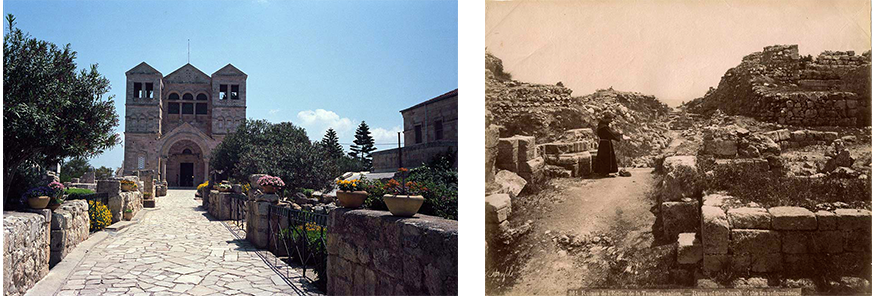
A photo of the Roman Catholic Church of the Transfiguration atop Mount Tabor alongside a nineteenth century photograph, which shows a monk among the ruins of an ancient church at the same location. Phot. (L) Norbert Schiller, (R) N. Schiller, Bonfils
Jenin, on the other hand retains little evidence of its less troubled days. Immediately after crossing at Jalameh, one of the checkpoints that separate Israel from the West Bank, a different reality sets in. First the sight of Palestinian day laborers crossing back home with their heavy burlaps sacks stuffed with onions or whatever produce they were allowed to take from the fields that day brings to life the economic predicament of Palestine. But there is more than that. The city still reels from the devastating effect of the second Intifada when Israeli forces launched a brutal land and air campaign against Jenin’s refugee camp. The Battle of Jenin is still encrusted in this city’s collective memory and everyone has a story to tell from these dark days. One of the most widely circulated is the heroic feat of Dr. Khalil Suleiman, head of emergency services at the Palestinian Red Crescent Society, who braved Israeli shelling to evacuate a wounded girl from the camp. Suleiman was killed when the ambulance was targeted and, as a testimony to his courage, the Jenin hospital now bears his name. The mangled remains of his ambulance were turned into a horse sculpture which stands at the hospital entrance.

A photo of a neighborhood on the outskirts of Jenin alongside a nineteenth century color photochrome showing a similar view of the town. Phot. (L) Norbert Schiller, (R) N. Schiller Collection, Bonfils
However, Jenin was not always so grim. The Canaanites, who ruled Palestine before it was conquered by the Israelites in the 2nd millennium BC, referred to Jenin as En Ganeem or Gina which could be the plural of garden or paradise, in reference to Jenin’s location on the edge of the Jezreel valley. The town is mentioned several times in the correspondences between the Pharaohs and local rulers as recorded in the Amarna letters, clay tables found at Tel el Amarna in Egypt. According to Christian tradition, Jesus frequently passed through Jenin en route from Nazareth to Jerusalem.
After Jenin the landscape opens up into a scenery of rolling hills with patches of olive and almond trees and huge cacti carrying fruit and bright yellow and orange flowers. Here, history is still palpable. The car dropped us off at Faqqu’a which lies just beneath the ridge of Mount Gilboa or Jebel Faqqu’a, the site of a historical battle which resulted in the death of King Saul and his sons at the hands of the Philistines. David, who succeeded Saul, is said to have declared Gilboa a cursed place as he lamented the deaths. However, this ancient curse does not seem to have put a damper on nature which displays some of its finest in this region of Palestine, known for its burst of colors in spring. In fact, the word Gilboa, and its Arabic equivalent Faqqu’a, means to burst which could be a reference to springs emanating from the rocks. The most famous flower from this area is the purple blue Faqqu’a iris which was proclaimed the national flower of Palestine.

A photo of cactus plants with Jebel Faqqu’a in the background alongside a nineteenth century photograph showing the same ridge identified by its biblical name, Mount Gilboa, and the Plain of Megiddo. Phot. (L) Norbert Schiller, (R) N. Schiller Collection, Frank Mason Good
On this segment of the hike we walked through the most fertile portions of the West Bank past the village of Jalboun, down Wadi el Diba’ or the Valley of the Hyenas, and back up towards al Mughayyer before reaching our destination at Zababdeh, the only mainly Christian village in the northern West Bank. One of the accounts that legitimize the village as a biblical site is that Mary passed through here with her cousin Elizabeth, mother of John the Baptist. Moreover, Zababdeh is rich in Christian ruins some of which date back to the Byzantine era and are still buried underground. The more recent Christian sites consist of nineteenth and twentieth century churches that belong to the Catholic, Anglican, Melkite and Greek orthodox communities. In addition to its religious significance, Zababdeh houses the Arab American University of Jenin, a private institution established in 2000 in collaboration with California State University.
Our host at Zababdeh was activist priest Abuna Firas Khoury who reopened the Catholic Melkite Church in 2002 after a 20 year closure. Khoury, a self-proclaimed trouble maker, is inspired by the model of South Africa where the church played a major part in mobilizing the masses in their fight for freedom. In this quest to break the Palestinians’ isolation and expose the injustices that they endure on a daily basis, Khoury has established a network of friends and supporters across the world who regularly travel to the West Bank to help its Arab population. He openly accuses the church leadership of passivity which only serves Israel’s goals and prolongs the occupation. On a social level, Khoury is involved in projects that promote the empowerment of women and the youth.
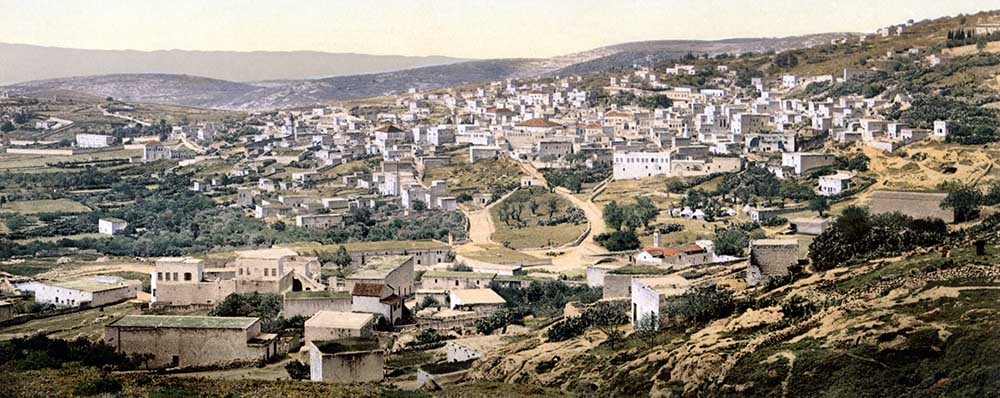
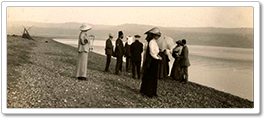
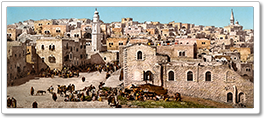
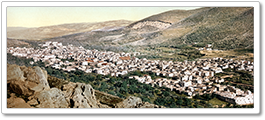
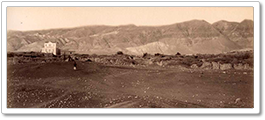
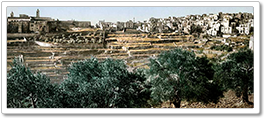
Very well done. Great to see the old photos besides the photos Norbert made. The text is very good reading. Mabrouk!
Great work, thank you for sharing. I really lioked the text and the juxtaposition of images. Looking forward to more of Zina/Norbert collaborations.
Vlad (Belgrade)
Superb. Cannot hardly wait to read more.
Now, on to the website.
Lovely prose accompanied by stunning photographs. I have learnt so much reading this. Thank you for sharing this journey you wonderful two and thanks for bringing Palestine closer to us.
Loved experiencing this personal journey that portrayed a Palestine unseen by the masses–with warm and hospitable people on a land rich with history and beauty. The photos were stunning in their similarities, from the old to the new. Thank you for sharing!